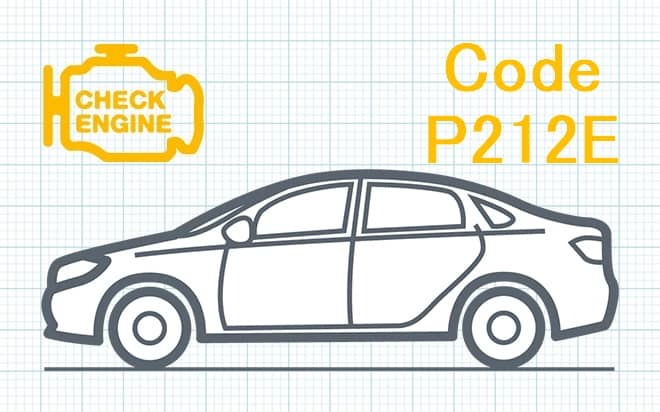
P212E Throttle Position Sensor / Switch G Circuit Intermittent
Content
P212E Throttle Position Sensor / Switch G Circuit Intermittent
OBD-II DTC Datasheet
Throttle Position Sensor / Switch Circuit Malfunction "G"
What does this mean?
This Diagnostic Trouble Code (DTC) is a generic transmission code, which means it applies to all 1996 vehicles (Dodge, Chrysler, Hyundai, Jeep, Mazda, etc.). Although general in nature, the specific repair steps may differ depending on the brand / model.
From my own experience, I have found that a stored code P212E means the powertrain control module (PCM) has detected an intermittent failure in the throttle position sensor "G" (TPS) circuit.
The TPS is usually a potentiometer type sensor that closes the voltage reference circuit. The TPS is mechanically actuated using a throttle shaft extension or a specially designed tongue on the sensor. When the throttle valve opens and closes, the contacts in the sensor move across the PCB, changing the resistance of the sensor. When the resistance of the sensor changes, the voltage on the TPS circuit fluctuates. The PCM recognizes these fluctuations as different degrees of throttle actuation.
The PCM uses input voltage signals from the TPS to calculate fuel delivery and ignition timing. It also uses TPS inputs to control intake air flow, exhaust oxygen content, exhaust gas recirculation (EGR) function, and engine load percentage.
If the PCM detects a specified number of intermittent or intermittent signals from the TPS for a set period of time and a programmed set of circumstances, P212E will be stored and a Malfunction Indicator Lamp (MIL) may illuminate.
Severity and symptoms
TPS plays an important role in engine handling, so a stored P212E code should be handled with some degree of urgency.
Symptoms of a P212E code may include:
- Oscillation on acceleration
- Black smoke from engine exhaust (especially when starting)
- Delay in engine start (especially at cold start)
- Reduced fuel efficiency
- Stored emission codes can accompany P212E.
reasons
Possible causes of this engine code include:
- Defective or incorrectly configured TPS
- Open or short circuit in the wiring or connectors TPS "G"
- Throttle body stuck or damaged
- Bad PCM or PCM programming error
Diagnostic and repair procedures
A good starting point is always to check the Technical Service Bulletins (TSB) for your particular vehicle. Your problem may be a known issue with a known manufacturer-released fix and could save you time and money while troubleshooting.
I usually use a diagnostic scanner, digital volt / ohmmeter (DVOM) and accurate vehicle information source (ALL DATA DIY) to diagnose the P212E code.
A successful diagnosis usually begins with a visual inspection of all wiring and connectors associated with the system. I also like to check the throttle body for signs of coking or damage. Repair or replace faulty wiring or components as necessary, then recheck the throttle body and TPS.
Connect the scanner to the diagnostic connector; retrieve all stored fault codes and write them down for future reference. I also save all associated freeze frame data. My notes are often helpful if the saved code turns out to be intermittent. Then I would clear the codes and test drive the car. If the code is cleared, continue diagnostics. If not reset, the condition may worsen before a correct diagnosis can be made. Drive normally until the PCM enters ready mode or the code is cleared.
Continue checking the Service Bulletins (TSBs) that are specific to the specific fault (and vehicle) in question by contacting your vehicle information source. If possible, use the information in the appropriate TSB to aid in the diagnosis. TSBs can be especially helpful in diagnosing erratic conditions.
The scanner data stream can provide useful information about faults and inconsistencies in the throttle position sensor. If you narrow the scanner data stream to display only the relevant data, you will get a more accurate answer.
If no failures are found, use the DVOM to check the TPS. Using the DVOM gives you access to real-time data as long as the appropriate test leads are connected to ground and signal circuits. Observe the DVOM display while manually operating the throttle. Note voltage interruptions as the throttle valve is slowly actuated from a closed position to a fully open position. The voltage typically ranges from 5V closed throttle to 4.5V wide open throttle. If faults or other inconsistencies are found, suspect that the sensor under test is defective or misconfigured.
Additional diagnostic notes:
- If the TPS has been replaced and the P212E is still stored, contact your vehicle information source for information on TPS settings.
- Use a DVOM (with test leads connected to ground and signal circuits) to fine-tune the TPS.
Related DTC discussions
- There are currently no related topics in our forums. Post a new topic on the forum now.
Need more help with code p212e?
If you still need help with DTC P212E, post a question in the comments below this article.
NOTE. This information is provided for informational purposes only. It is not intended to be used as a repair recommendation and we are not responsible for any action you take on any vehicle. All information on this site is protected by copyright.

